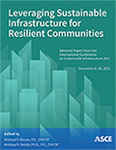Eat Prosperity Campaign: Techno-Economic Forecasting of a Food Waste Collection Scheme for Growing Economically Sustainable Algae on Landfills
Publication: Leveraging Sustainable Infrastructure for Resilient Communities
ABSTRACT
Global mean surface temperatures and global methane emissions have steadily risen over the past 40 years. Residential food waste disposal has increased by as much as 30% since the beginning of the COVID-19 pandemic, and landfills are reaching capacity more quickly as up to 40% of food is thrown into the trash. A residential food disposal collection campaign to recycle food waste and carbon emissions could be implemented to grow economically sustainable algae on landfills. NASA Surface Attached BioReactor (SABR) technology optimizes growth performance of algae, reduces the capital expenditure by 69% compared to clear polyvinyl chloride (PVC) photobioreactors, and the landfill infrastructure reduces the operational costs for growing algae by 42%. The novel Eat Prosperity Campaign food waste collection and landfill biodiesel model may outcompete standard drilling methods, yielding revenue greater than $100 million, diverting more than 200,000 t of municipal solid waste, and recycling 13,000 t2 of methane from food waste annually, per county landfill. The Eat Prosperity Campaign model for food waste collection provides a significant abatement of global greenhouse gas emissions potential within a communal behavioral change. By allowing residents within communities the opportunity to recycle at the source of disposal and actively participate, business-as-usual estimations of global greenhouse gas emissions could be offset by as much as 47 GtCO2 in 20 years compared to current 2030 projected estimates.
Get full access to this article
View all available purchase options and get full access to this chapter.
REFERENCES
Ali, N., et al. “Making Biofuels from Microalgae - A Review of Technologies.” Journal of Food Science and Technology (2014): 007–014.
Bai, R., et al. “Silver nanofiber assisted lipid extraction from biomass of a Louisiana Chlorella vulgaris/Leptolyngbya sp. co-culture.” Chemical Engineering Journal. 225. 100–108 (2012). https://doi.org/10.1016/j.cej.2013.03.075.
Berkeley Earth. “Global Temperature Report for 2019.” January 15, 2020. http://berkeleyearth.org/archive/2019-temperatures/.
Bogner, J., et al. “Mitigation of Global Greenhouse Gas Emissions from Waste: Conclusions and Strategies from the Intergovernmental Panel on Climate Change (IPCC) Fourth Assessment Report. Working Group III (Mitigation).” Waste Management & Research, vol. 26, no. 1, Feb. 2008, pp. 11–32, doi:https://doi.org/10.1177/0734242X07088433.
Bogner, J., and Spokas, K. A. 2009. Landfill Methane. In: Reay, D., Smith, P., and van Amstel, A. Methane and Climate Change. Earthscan Ltd., London, UK. pp. 175–200. https://www.ars.usda.gov/research/publications/publication/?seqNo115=241660.
Cui, M., et al. “Warmer temperature accelerates methane emissions from the Zoige wetland on the Tibetan Plateau without changing methanogenic community composition.” Scientific reports vol. 5 11616. 25 Jun. 2015, doi:10.1038/srep11616.
Davis, R., Aden, A., and Pienkos, P. T. Techno-Economic Analysis of Autotrophic Microalgae for Fuel Production. United States: N. p., 2011. doi:https://doi.org/10.1016/j.apenergy.2011.04.018.
Das, K. C., Chinnasamy, S., Shelton, J., Wilde, S. B., Haynie, R. S., and Herrin, J. A. “Production of Biofuel using Molluscan Pseudofeces Derives from Algal Cells.”, 2012 August 28.
Edwards, J. B. Silver Bullets II - Energy Independence & Industrial Renaissance. San Diego, CA: Aventine Press, 2011.
“Fight Climate Change by Preventing Food Waste.” World Wildlife Fund. (2021). https://wwf.panda.org/discover/our_focus/food_practice/food_loss_and_waste/driven_to_waste_global_food_loss_on_farms/.
Floyd, B., Fujibayashi, T., and Takeuchi, S. “Phase Calibration Circuit and Method for Multi-Channel Radar Receiver.”, 2016 September 27.
“Food: Material-Specific Data.” United States Environmental Protection Agency, 2018. https://www.epa.gov/facts-and-figures-about-materials-waste-and-recycling/food-material-specific-data.
“Food Wastage Footprint & Climate Change.” Food and Agricultural Organization of the United Nations (2011). http://www.fao.org/documents/card/en/c/7338e109-45e8-42da-92f3-ceb8d92002b0/.
“Food Waste FAQs.” United States Department of Agriculture (2010). https://www.usda.gov/foodwaste/faqs#:~:text=In%20the%20United%20States%2C%20food,worth%20of%20food%20in%202010.
EPA Landfill Methane Outreach Program. “Methane Emissions from Landfills.” United States Environmental Protection Agency (2020). https://www.epa.gov/lmop/basic-information-about-landfill-gas.
Jiang, Q., Yu, W., Mosleh, A., Liu, C., Wang, D., Tu, X., Liu, Y., Ognier, S., Wangila, G., Cao, B., and Guo, Z. (2018). Environment, Energy, Sustainability: Journal- ES Energy & Environment. Engineered Science. https://doi.org/10.30919/es8d746.
Kinley, R. D., de Nys, R., Vucko, M. J., Machado, L., and Tomkins, N. W. (2016). The red macroalgae Asparagopsis taxiformis is a potent natural antimethanogenic that reduces methane production during in vitro fermentation with rumen fluid. Animal Production Science. 56. 282. https://doi.org/10.1071/AN15576.
Lachmann, S. C., Mettler‐Altmann, T., Wacker, A., and Spijkerman, E. “Nitrate or ammonium: Influences of nitrogen source on the physiology of a green alga.” Ecology and evolution vol. 9,3 1070–1082. 10 Jan. 2019, doi:https://doi.org/10.1002/ece3.4790.
McKinsey&Company. (2013). Pathways to a low-carbon economy: Version 2 of the global greenhouse gas abatement cost curve. Available at: https://www.cbd.int/financial/doc/Pathwaystoalowcarboneconomy.pdf.
Murphy, T., Fleming, E., Bebout, L., Bebout, B., and Berberoglu, H. (2012). A novel microbial cell cultivation platform for space applications. Sci. Tech. Ser. 114. 335–339.
National Oceanic & Atmospheric Administration. “Global CH4 Monthly Means.” Global Monitorinng Laboratory, Earth System Research Laboratories, Mar 5, 2021. https://www.esrl.noaa.gov/gmd/ccgg/trends_ch4/.
Ramos, J.-L., Valdivia, M., García‐Lorente, F. and Segura, A. “Benefits and perspectives on the use of biofuels.” Microbial biotechnology vol. 9,4 (2016): 436–40. doi:10.1111/1751-7915.12356.
Till, B. E., Huntington, J. A., Posri, W., Early, R., Taylor-Pickard, J., and Sinclair, L. A. “Influence of rate of inclusion of microalgae on the sensory characteristics and fatty acid composition of cheese and performance of dairy cows.” J Dairy Sci. 2019 Dec;102(12):10934–10946. doi: https://doi.org/10.3168/jds.2019-16391. Epub 2019 Sep 25. 31563312.
Zhu, Y., and Dunford, N. T. Growth and Biomass Characteristics of Picochlorum oklahomensis and Nannochloropsis oculata. J Am Oil Chem Soc 90, 841–849 (2013).
Zhu, Y., Jones, S. B., and Anderson, D. B. 2018. Algae Farm Cost Model: Considerations for Photobioreactors. Richland, WA: Pacific Northwest National Laboratory.
Information & Authors
Information
Published In
History
Published online: Jan 20, 2022
Authors
Metrics & Citations
Metrics
Citations
Download citation
If you have the appropriate software installed, you can download article citation data to the citation manager of your choice. Simply select your manager software from the list below and click Download.
